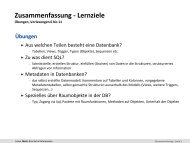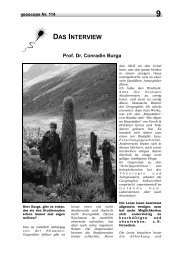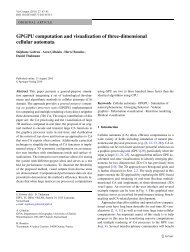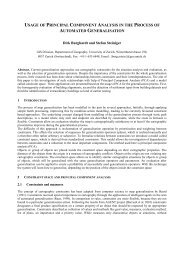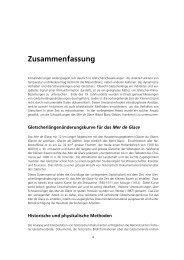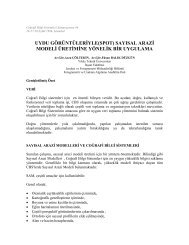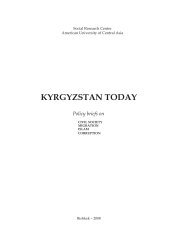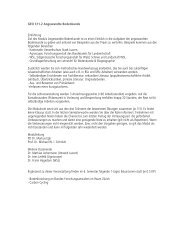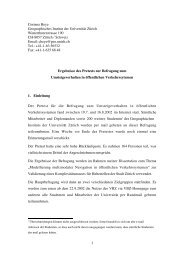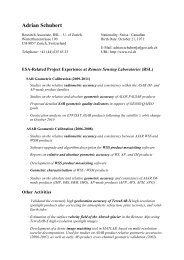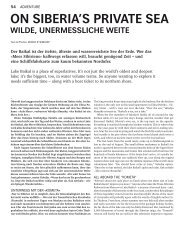download paper in english
download paper in english
download paper in english
You also want an ePaper? Increase the reach of your titles
YUMPU automatically turns print PDFs into web optimized ePapers that Google loves.
Tont<strong>in</strong>es <strong>in</strong> Cameroon<br />
Page 1<br />
D+C Development and Cooperation (No. 1, January/February 2001,<br />
p. 21-22)<br />
Tont<strong>in</strong>es <strong>in</strong> Cameroon<br />
L<strong>in</strong>k<strong>in</strong>g Traditional and Semi-formal F<strong>in</strong>anc<strong>in</strong>g Systems<br />
Jean-Marc Sika and Balz Strasser<br />
Local tont<strong>in</strong>es <strong>in</strong> Cameroon, small, <strong>in</strong>formal sav<strong>in</strong>gs and loan associations, are prov<strong>in</strong>g to<br />
be still the ma<strong>in</strong> grassroots f<strong>in</strong>anc<strong>in</strong>g system. The people handle about 90 per cent of their<br />
f<strong>in</strong>ancial transactions through them. By comparison, the formal and semi-formal f<strong>in</strong>ance<br />
sector, mean<strong>in</strong>g commercial and sav<strong>in</strong>gs and loan banks, achieves a volume of only about<br />
10 per cent of national loan bus<strong>in</strong>ess. But the tont<strong>in</strong>es are of limited use for long-term<br />
<strong>in</strong>vestments and probably have a negative impact on durable economic growth. Jean-<br />
Marc Sika and Balz Strasser describe a new system be<strong>in</strong>g tested by a village cooperative<br />
<strong>in</strong> Bansoa which is aimed at clos<strong>in</strong>g this gap.<br />
Cameroon has a population of 14 million, of which 7.5 million are economically active. To<br />
date, about 700,000 bank accounts have been opened, divided <strong>in</strong>to 250,000 bus<strong>in</strong>ess and<br />
450,000 private accounts. A total of 800 sav<strong>in</strong>gs and loan cooperatives with 250,000 members<br />
operates <strong>in</strong> the semi-formal f<strong>in</strong>ance sector. Only about 10 per cent of the economically active<br />
population is reached via the channels of these two groups of f<strong>in</strong>ance <strong>in</strong>stitutions. The majority<br />
of the people obta<strong>in</strong> their loans <strong>in</strong> the <strong>in</strong>formal f<strong>in</strong>ance sector. This sector consists of private<br />
moneylenders, <strong>in</strong>formal traders and the tont<strong>in</strong>es. What are tont<strong>in</strong>es and what significance do<br />
they have for the country's economy?<br />
Difficult def<strong>in</strong>ition<br />
Due to their hybrid nature - a mixture of social and f<strong>in</strong>ancial functions - the tont<strong>in</strong>es are<br />
difficult to def<strong>in</strong>e. Typically, people who get together <strong>in</strong> these sav<strong>in</strong>gs and loan associations<br />
feel bound to each other <strong>in</strong> some way. There are family and neighbourhood tont<strong>in</strong>es, and others<br />
among craftspeople and farmers. Common relationships or <strong>in</strong>terests are <strong>in</strong> the foreground. That<br />
strengthens social control and ensures that the tont<strong>in</strong>es work.<br />
The tont<strong>in</strong>es <strong>in</strong> Cameroon can be classified as two types, both of which have variants. Despite<br />
the already marked differences among them, new variants arise all the time. Their ability to<br />
adjust to constantly chang<strong>in</strong>g social conditions and the <strong>in</strong>exhaustible imag<strong>in</strong>ation of their<br />
promoters br<strong>in</strong>g about ever new forms of tont<strong>in</strong>es.<br />
The first tont<strong>in</strong>e type is a rotat<strong>in</strong>g sav<strong>in</strong>gs system. The members of these tont<strong>in</strong>es meet at fixed<br />
<strong>in</strong>tervals, usually weekly or monthly, and pay <strong>in</strong> a certa<strong>in</strong> sum of money agreed at the<br />
beg<strong>in</strong>n<strong>in</strong>g of the round. The total amount collected is loaned to a different member each month.<br />
From that moment on there are two common variants. In the first, the sequence of the members<br />
who receive the money is determ<strong>in</strong>ed <strong>in</strong> advance by consensus. The number of the members<br />
produces the number of the loan periods and def<strong>in</strong>es the length of a loan cycle. An equal<br />
amount of money is distributed each month, free of <strong>in</strong>terest.<br />
Loan auctions<br />
In another variant of this type of tont<strong>in</strong>e, the money collected is auctioned and all members of<br />
the current round who have not yet received a loan may bid for it. The money goes to the<br />
highest bidder. The 'profit' made <strong>in</strong> this ma<strong>in</strong> money market is then divided <strong>in</strong>to small amounts<br />
which also are auctioned. The money from this secondary market is treated as short-term loans<br />
which must be repaid, together with <strong>in</strong>terest, with<strong>in</strong> a few weeks. If the amount of money from<br />
the secondary market is large enough it is transferred to the ma<strong>in</strong> market and offered <strong>in</strong> the<br />
http://www.<strong>in</strong>went.org/E+Z/1997-2002/de101-8.htm<br />
20.05.2005 15:12:20
Tont<strong>in</strong>es <strong>in</strong> Cameroon<br />
Page 2<br />
subsequent tont<strong>in</strong>e round. This means that every member w<strong>in</strong>s a 'free' round. The tont<strong>in</strong>e ends<br />
as soon as all members have been paid once. The loans of the secondary money market are<br />
collected <strong>in</strong> the last round and distributed equally to all members, and a new round can beg<strong>in</strong>.<br />
Both variants of this tont<strong>in</strong>e type are oriented on sav<strong>in</strong>gs.<br />
The second tont<strong>in</strong>e type is loan-oriented. Pay-<strong>in</strong>s are not fixed <strong>in</strong> advance, but depend basically<br />
on what the members can afford. The money collected is similar to a jo<strong>in</strong>t fund, which is<br />
available to <strong>in</strong>dividual members as a loan stock. At every tont<strong>in</strong>e round repayments and new<br />
contributions are divided <strong>in</strong>to packets of money whose amount depends on the number of<br />
members tak<strong>in</strong>g part and the level of loans they seek. An arbitration body is often essential to<br />
satisfy all members. In this case the loans have a shorter term, usually one month, and <strong>in</strong>terest<br />
is set at 5-10 per cent per month. The tont<strong>in</strong>e cycle ends when the term set by this round<br />
matures. This can be <strong>in</strong> August, when the aim is to fund the costs of children start<strong>in</strong>g school, or<br />
<strong>in</strong> December, to cover the extra expenses of celebrations to mark the end of the year. At such<br />
fixed times the tont<strong>in</strong>e pays out the members' sav<strong>in</strong>gs, plus <strong>in</strong>terest earned, which depends on<br />
the amount saved and the term of the loan. S<strong>in</strong>ce both types of tont<strong>in</strong>es have complementary<br />
roles (the build<strong>in</strong>g up of <strong>in</strong>vestment loans or sav<strong>in</strong>gs), both often can be found <strong>in</strong> <strong>in</strong>terplay<br />
with<strong>in</strong> one group.<br />
Strengths and weaknesses<br />
of tont<strong>in</strong>es<br />
For the majority of the people, who have no access to the formal bank<strong>in</strong>g system, the tont<strong>in</strong>es'<br />
sav<strong>in</strong>gs and loan functions are a necessary alternative. They provide a large section of the<br />
population with f<strong>in</strong>ancial services, and their members can better manage their own cash flows<br />
over a year or more. Also, because the tont<strong>in</strong>es are self-adm<strong>in</strong>istered they can be adjusted at<br />
any time to the chang<strong>in</strong>g needs of <strong>in</strong>dividual members. Aga<strong>in</strong>st a background of great<br />
economic and social <strong>in</strong>security, this flexibility is very important and certa<strong>in</strong>ly one of the<br />
tont<strong>in</strong>es' success factors. Another positive feature of the tont<strong>in</strong>es is their high repayment rate.<br />
This is the result of a system based entirely on the mutual trust of the members and do<strong>in</strong>g<br />
without collateral which would exclude many people. The network of social relationships <strong>in</strong><br />
which the actors live is structured <strong>in</strong> such a way that they depend on the help and solidarity of<br />
each other. So it is <strong>in</strong> every member's <strong>in</strong>terest to pay <strong>in</strong> the fixed sums regularly and repay<br />
loans on time. If they do not, they risk exclusion not only from their own tont<strong>in</strong>e but from the<br />
whole system. And no-one can afford that.<br />
But the tont<strong>in</strong>es also have some weak spots which preclude us<strong>in</strong>g them as a means of f<strong>in</strong>anc<strong>in</strong>g<br />
the <strong>in</strong>vestment needed for Cameroon's economic development. One of their first weaknesses is<br />
that they cannot convert their short-term sav<strong>in</strong>gs stocks <strong>in</strong>to long-term loans, which,<br />
<strong>in</strong>cidentally, is also a still-unresolved problem <strong>in</strong> the country's formal bank sector. One obstacle<br />
is the shortness of the tont<strong>in</strong>e cycle. A second problem l<strong>in</strong>ked with that is the low level of the<br />
loan sums, and f<strong>in</strong>ally the high <strong>in</strong>terest rates are not an <strong>in</strong>centive to use tont<strong>in</strong>e loans to f<strong>in</strong>ance<br />
long-term projects.<br />
Only short-term loans<br />
The limit on sav<strong>in</strong>g is due ma<strong>in</strong>ly to the duration of a tont<strong>in</strong>e's cycle, which is determ<strong>in</strong>ed by<br />
the number of its members. The tont<strong>in</strong>es' <strong>in</strong>stitutionalised life of a maximum of 12 months<br />
means they cannot f<strong>in</strong>ance longer-term projects. That is especially so s<strong>in</strong>ce all their accounts<br />
must be balanced out to zero at the end of every round. Sav<strong>in</strong>gs plus <strong>in</strong>terest are paid out to the<br />
members, and borrowers must acquit their loans by that deadl<strong>in</strong>e. Only then can the next round<br />
beg<strong>in</strong>.<br />
If one wished to make greater <strong>in</strong>vestments it would <strong>in</strong> theory be possible to accumulate the<br />
sav<strong>in</strong>gs of various tont<strong>in</strong>es until the required amount was available. One could also th<strong>in</strong>k of<br />
carry<strong>in</strong>g forward repaid sums <strong>in</strong>to the next round. But the time-gap between the end of one<br />
round and the beg<strong>in</strong>n<strong>in</strong>g of the next is the ma<strong>in</strong> problem here. Dur<strong>in</strong>g this 'downtime' the<br />
people have the cash <strong>in</strong> their pockets, with all the well-known consequences. In the social<br />
context of Cameroon, it is often impossible to keep the money <strong>in</strong>tact until the next round<br />
beg<strong>in</strong>s.<br />
The terms of the tont<strong>in</strong>e loans present a similar problem. The repayment period of one to a<br />
maximum of two months allows only <strong>in</strong>vestments which also pay off <strong>in</strong> a short time. This<br />
means the loans are attractive ma<strong>in</strong>ly for f<strong>in</strong>anc<strong>in</strong>g short-term and mostly speculative activities<br />
and not for long-term productive projects. Another weakness of the tont<strong>in</strong>e as a loan <strong>in</strong>strument<br />
http://www.<strong>in</strong>went.org/E+Z/1997-2002/de101-8.htm<br />
20.05.2005 15:12:20
Tont<strong>in</strong>es <strong>in</strong> Cameroon<br />
Page 3<br />
is the high cost of its credits at 5-10 per cent per month. One reason for that is that it has<br />
always been done that way, and another is that there is still a certa<strong>in</strong> risk <strong>in</strong> be<strong>in</strong>g a member of<br />
a tont<strong>in</strong>e.<br />
Assum<strong>in</strong>g that development of Cameroon's rural regions is not possible without the existence<br />
of local and long-term loan funds on affordable terms, the money available by means of the<br />
tont<strong>in</strong>es is <strong>in</strong>sufficient. That limits markedly the production capacity of the poorer people, and<br />
particularly that of the women.<br />
An approach to a solution:<br />
build bridges and use synergies<br />
The Caisse Populaire de Banéghang, a sav<strong>in</strong>gs and loan cooperative <strong>in</strong> Bansoa, a village <strong>in</strong><br />
West Cameroon, has been test<strong>in</strong>g a new approach s<strong>in</strong>ce 1999. It is develop<strong>in</strong>g a new type of<br />
loan system that l<strong>in</strong>ks the traditional tont<strong>in</strong>e with the classic loan structure of a semi-formal<br />
f<strong>in</strong>ance <strong>in</strong>stitution. The idea is to comb<strong>in</strong>e the advantages of the proven tont<strong>in</strong>e system -<br />
flexibility, solidarity, self-responsibility and group drive - with the attractive terms of the loan<br />
cooperative, above all <strong>in</strong> longer and more favorable loans.<br />
Members of a cooperative who wish to take out a loan must provide collateral. This can be a<br />
parcel of land, or a well-known person can act as guarantor. But this system is disadvantageous<br />
for women <strong>in</strong> particular because for cultural reasons they hardly own any land, especially <strong>in</strong><br />
rural regions. To remedy this shortcom<strong>in</strong>g, the Caisse is develop<strong>in</strong>g a loan system for the<br />
village women's groups that are organised <strong>in</strong> tont<strong>in</strong>es. The basic idea is that the tont<strong>in</strong>e as a<br />
group will be an active member of the cooperative and thus have the usual rights and duties of<br />
membership. The first obligation is regularly to make a sav<strong>in</strong>gs deposit <strong>in</strong>to the tont<strong>in</strong>e account<br />
at the Caisse. This account will accumulate dur<strong>in</strong>g the tont<strong>in</strong>e round by means of the regular<br />
deposits of its various members. The tont<strong>in</strong>e group will then be able to apply for a loan from<br />
the cooperative. Before then, the Caisse's management will help every tont<strong>in</strong>e member to draw<br />
up their own <strong>in</strong>vestment plan with<strong>in</strong> the framework of their personal opportunities for<br />
development. Every member will be able to decide for themselves <strong>in</strong> which sector the money is<br />
to be <strong>in</strong>vested. The total sum of the planned <strong>in</strong>vestments will then be compiled <strong>in</strong> a portfolio.<br />
The tont<strong>in</strong>e will now apply for a loan match<strong>in</strong>g the value of the portfolio, and the money<br />
allocated will be distributed among the group accord<strong>in</strong>g to the agreed <strong>in</strong>vestment plans. The<br />
repayment period is usually 23-36 months because Cameroon has no <strong>in</strong>stitutions that bear the<br />
risk of longer-term loans. At every tont<strong>in</strong>e meet<strong>in</strong>g all members pay <strong>in</strong> the redemption<br />
<strong>in</strong>stalments on their loans, and the total sum is paid to the Caisse.<br />
The uniqueness of this system is that it is not the <strong>in</strong>dividual members that are <strong>in</strong>debted to the<br />
cooperative, but the tont<strong>in</strong>e as an <strong>in</strong>stitution. The members <strong>in</strong>cur personal debt to the tont<strong>in</strong>e, as<br />
before. The social pressure and marked solidarity with<strong>in</strong> the tont<strong>in</strong>e encourages every member<br />
to pay his or her <strong>in</strong>stalments on time. That means there is no need for the sureties usually<br />
required for a loan from the cooperative. There is trust <strong>in</strong> a traditional system that is anchored<br />
strongly among the local people and has over decades guaranteed high repayment rates. But the<br />
real advantage of a l<strong>in</strong>k with the cooperative is both the level and term of the loans and their<br />
favorable price. The <strong>in</strong>terest rate is 20 per cent per year (1.8 per cent per month), of which 18<br />
per cent is repaid to the Caisse and 2 per cent is set aside for the long-term build<strong>in</strong>g up of a<br />
guarantee fund. Every member can now <strong>in</strong>vest <strong>in</strong> projects which could not be f<strong>in</strong>anced with the<br />
meagre funds from a traditional source such as the tont<strong>in</strong>e.<br />
The follow<strong>in</strong>g example should expla<strong>in</strong> these advantages. A woman farmer who wants to buy<br />
organic fertiliser for her maize field has to pay F CFA 18,000 for it. Her maize crop takes three<br />
months before it can be harvested and a further three months until it has dried and can be sold.<br />
If she borrows the money from a tont<strong>in</strong>e she has two problems. First, the <strong>in</strong>terest rate of at least<br />
5 per cent per month is too high for her, and second she must repay the loan with<strong>in</strong> two<br />
months, before her maize can be harvested. That means that <strong>in</strong> order to be able to repay the<br />
first loan she must take out another, which usually costs even more. This is not an ideal<br />
solution. But backed by the guarantee of her tont<strong>in</strong>e she can borrow what she needs from the<br />
cooperative and has six months <strong>in</strong> which to repay the loan <strong>in</strong> <strong>in</strong>stalments. Every month she pays<br />
F CFA 3,000 (18,000:6) plus 1.8 per cent <strong>in</strong>terest <strong>in</strong>to the tont<strong>in</strong>e. Even with this solution she<br />
must beg<strong>in</strong> to repay the loan before she earns the profit from her maize crop, but s<strong>in</strong>ce the<br />
monthly <strong>in</strong>stalments are low she can cover them out of other <strong>in</strong>come.<br />
Every tont<strong>in</strong>e group should, however, cont<strong>in</strong>ue with their traditional activities, for although<br />
tont<strong>in</strong>e loans are not suitable for long-term <strong>in</strong>vestments that does not mean they should no<br />
longer be considered for other purposes. On the contrary, depend<strong>in</strong>g upon the sector <strong>in</strong>volved<br />
http://www.<strong>in</strong>went.org/E+Z/1997-2002/de101-8.htm<br />
20.05.2005 15:12:20
Tont<strong>in</strong>es <strong>in</strong> Cameroon<br />
Page 4<br />
it can make sense to take out a short-term expensive loan to f<strong>in</strong>ance some speculative bus<strong>in</strong>ess.<br />
And aga<strong>in</strong>st a background of a lack of liquidity and high transaction costs it is also useful to be<br />
able to cover important, short notice expenditure.<br />
Jean-Marc Sika is a f<strong>in</strong>anc<strong>in</strong>g specialist and head of the Productive Credit and Women <strong>in</strong><br />
Development Programme (PCWID) of the Netherlands Volunteers Foundation (SNV) <strong>in</strong><br />
Bamenda, Cameroon.<br />
Zurich-based Balz Strasser is an agricultural economist who is currently work<strong>in</strong>g on <strong>in</strong>formal<br />
f<strong>in</strong>ance <strong>in</strong>stitutions and l<strong>in</strong>kage-build<strong>in</strong>g <strong>in</strong> Cameroon.<br />
D+C Development and Cooperation,<br />
published by: Deutsche Stiftung für <strong>in</strong>ternationale Entwicklung (DSE)<br />
Editorial office, postal address:<br />
D+C Development and Cooperation, P.O. Box, D-60268 Frankfurt, Germany.<br />
E-Mail: HDBrauer@cs.com<br />
Contents<br />
Top of page<br />
German FoundatiDevelopmInternationalEducDevelopmenCentre for EcoArea OriPublic AdmiIndustrial OccuCentre for Food, RuPublic He<br />
[D + C Onl<strong>in</strong>e][Databases][Landes<strong>in</strong>fos][Highlights][News][L<strong>in</strong>ks]<br />
Copyright © 2001, DSE, January 10, 2001<br />
http://www.<strong>in</strong>went.org/E+Z/1997-2002/de101-8.htm<br />
20.05.2005 15:12:20





